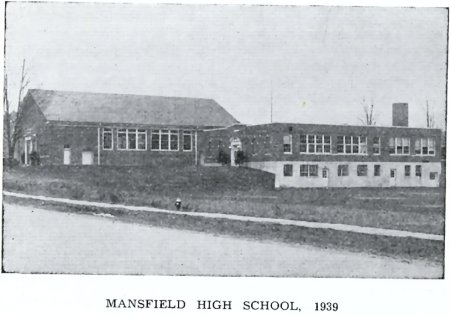|
This decade, although it was the period of the "Great Depression", was one in which great changes and many improvements took place in Mansfield. By 1930 a franchise had been granted by the Council and Natural Gas was brought into town. Straughn Hall at the College, was completed. Due to efforts from 1930-34 an appropriation of $45,000.00 was secured for an Armory Building and it was built in 1936. The new Shop Building at the College was constructed. In 1934 a new Vocational Building was built at the High School and in 1938-39 the new Senior High School was built. A. H. Vosburg was of great help in securing money and watching the development of this project. A bond issue of $42,500.00 was voted in 1937 for this purpose. In 1938 the contract was let for three new buildings at the College; Gymnasium Elementary School, Arts Building.
Mansfield shared more than most communities in the development of through bus lines, connecting the community more directly with the outside world than was the case in the days of the railroad passenger service. In 1929 the "Great Easter Stages" later the "Greyhound", a New York to Chicago line, started. There was also a line from Blossburg to Elmira and Corning, which later ran from Williamsport and now from Washington to Rochester and Buffalo. For some years the Martz lines also ran from New York west.
In connection with the Works Progress Administration and that of the so-called "Alphabetical Agencies" of the depression period, the Borough built, in 1934-35, a sewer on the north side of Corey Creek from Extension Street to the river with spurs on N. Academy and Main Streets. Altogether 4,900 feet were laid for which the Borough appropriated only $600.00. Also, in the same way, a great deal of work on the streets was done.
In 1937 a movement begun by the womens’ club culminated in the formation of a Community Chest to concentrate the giving of the citizens into one "drive" instead of the five which had been going on each year. All the organizations interested cooperated and a board was set up consisting of representatives of the business men, the schools, the welfare organizations, and the college faculty.
In 1936 the Business Men’s Association sponsored a Halloween party for the children of the community. This was very successful and has become an annual affair.
In 1939 skunks came to be such a nuisance in the Borough that the Council hired a man to trap them. His work was so successful that there has been no complaint since.
In 1929 the name "College" was substituted for "Normal" in names of streets. In 1933 the short street between highway six in its new location, and Brooklyn Street was named Ross Street; Meadow Street was extended to Corey Creek as had been originally intended. The Borough acquired a flushing truck and equipment and a new truck for street work. Ordinances were again passed to require sewer connections and to eliminate outside toilets (19310; to regulate excavations in paved streets; requiring proper pasteurization of all milk sold in the Borough (1932), regulating building by granting permits (1937).
Since the Borough was $6,500.00 in debt in 1930, the bonds authorized in 1924 and never issued, were sold.
In 1936 the Rural Electrification Agency started a Mansfield office and to extend electric lines from the town out into the rural areas.
The Doctors in the period were: Hughes Meaker, John Doane, L. J. Neal, I. R. Vincent, D. W. Crittenden from 1937; J. J. Moore from 1939.
The Dentists were: Adolph Schlappi, Robert DeWaters to 1932; J. E. Williamson, Joseph Jaquish, 1932-34; J. J. McMillan, 1934 on.
Veterinarian: R. J. Lynch.

Old HiSchool Above Church of Chrits (Disciples) , Canoe Camp at Right |
 |
